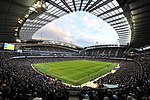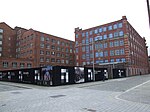B of the Bang

B of the Bang was a sculpture by Thomas Heatherwick next to the City of Manchester Stadium in Manchester, England, United Kingdom, which was commissioned to mark the 2002 Commonwealth Games; it was one of the tallest structures in Manchester and the tallest sculpture in the UK until the completion of Aspire in 2008. It was taller and leaned at a greater angle than the Leaning Tower of Pisa. The sculpture took its name from a quotation of British sprinter Linford Christie, in which he said that he started his races not merely at the "bang" of the starting pistol, but at "the B of the Bang". The sculpture was commissioned in 2003; construction overran and the official unveiling was delayed until 12 January 2005. Six days before the launch, the sculpture suffered the first of three visible structural problems as the tip of one of the spikes detached and fell to the ground. Legal action to repair the sculpture was started by Manchester City Council a year later, resulting in an out-of-court settlement totalling £1.7 million.In February 2009, Manchester City Council announced that the sculpture would be dismantled and placed in storage. Despite the promise of storage and potential reassembly, the core and legs of the sculpture were cut apart during removal. The core was sold for scrap in July 2012, with the 180 spikes reported to have been placed in storage for an undecided future use.
Excerpt from the Wikipedia article B of the Bang (License: CC BY-SA 3.0, Authors, Images).B of the Bang
Barking Street, Manchester Bradford
Geographical coordinates (GPS) Address Nearby Places Show on map
Geographical coordinates (GPS)
| Latitude | Longitude |
|---|---|
| N 53.481944444444 ° | E -2.1961111111111 ° |
Address
Etihad Campus
Barking Street
M40 7BT Manchester, Bradford
England, United Kingdom
Open on Google Maps






